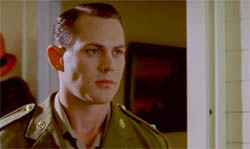Yarnmaker cinematographer Jason Kempnich is sharing the following information for flood victims to help them preserve flood water damaged photos and negatives. This information is offered as a helping guide - we are not responsible if your salvage attempts damage your photos.
DO NOT THROW YOUR FLOOD DAMAGED NEGATIVES AND PHOTOS OUT! They can be saved in many instances, but you must act fast to improve your chances. Be aware you may irreversibly damage some photos, but it is better to have some photos than none.
Photos:
If you have flood damaged photos, don't throw them out! Some intact photos (real photos, not inkjet prints) can be saved.
- If the photo is still damp, lightly rinse the photo in gently running cold water (distilled water is better if you can get it) to wash away the debris. Try not to touch the image area, as you may smudge it. You may need the running water to help prise apart stuck photos.
- Gently shake the photo dry as best you can.
- Fill an air tight container half full of kitty litter.
- Lay a sheet of plastic over the kitty litter and punch holes in the plastic.
- On top of the plastic, lay your photos out in an even layer.
- Seal the lid. The kitty litter will draw the moisture out of the photos.
- Check on the photos every few days until they are dry. Do not touch the image surface until the paper is dry - you might smudge the image.
Negatives and Transparencies:
Even if your photos are damaged, if you have the original negatives or transparencies (henceforth called film), you can get your photos REPRINTED almost as new! But you must act fast to save the film.
When film is developed, it is a wet process, so film is OK with a bit of water. But if the film remains damp for too long, the gelatine layer of the film can be ruined (where the image is stored) and it will grow mould too. When handling the film, be careful not to scratch either surface.
In all instances below, distilled water is better than tap water due to its lack of impurities, but if distilled water is too expensive or not easily available, using clean tap water is a better choice than not acting at all.
- Remove the film from any sleeves. Cut the sleeves open if you have to - do not scratch the film by pulling it out of debris-filled sleeves.
- Now place the film into a room temperature tub of clean water: around 21 degrees Celsius/70 degrees Fahrenheit. (We don't want the film to dry unless we are controlling the drying.)
- Inspect each strip for grit and wash it away under room temperature running water - grit will scratch the film permanently if the surface is rubbed.
- After the strip looks clear of debris, rub the entire length of the film strip in one smooth motion using your thumb and forefinger (no nails!) under water. This will help remove any muddy stains and your fingers will alert you to any debris that would otherwise scratch the film. If you feel slime, this is probably the gelatine layer breaking down - this means the film has been in water too long and the image is compromised, so do the best you can. It is better to lose one image on a strip than to lose the entire strip.
- Rinse the strip again under room temperature running water.
- Transfer the cleaned strip to a second tub of warm water, containing one or two drops of basic dish washing liquid such as Sunlight (scoop any suds off the top before using the bath!). The dish washing liquid acts as a setter, helping the film to dry without leaving water spots. Water spots can never be removed!
- After washing each strip in the second tub, inspect each one - they may need a final clean as described above, but by now the water should be mostly clean (replace the water and dish liquid if it gets dirty).
- With a flick of the wrist, shake excess water off the strip.
- Hang the film strips out to dry - an air conditioned environment set to under 22 degrees is best. Use paper clips to hang the film from the sprocket holes, OR a piece of cotton to string them together in a long line. The aim here is to have the film TOUCH NOTHING whilst drying. Where it touches something (another piece of film, a table top, etc) water will remain and the gelatine surface will break down, destroying the image.
- If you have done it right, the film strips should be dry in an hour in an air conditioned environment. However, keep them airing for as long as you can - if you pack film away with some moisture, mould will grow through the whole collection.
- Use purpose built film strip sleeves for long term storage.
When cleaning film, keep in mind that we want the film to be wet for as little time as possible. No doubt the film has already endured several days of being wet, so the cleaning process must be as fast as possible. But equally, you do not want the film to dry out during the process, least spot marks be permanently left.
Negatives that have already dried:
If your negatives have already dried out before you could clean them, use the same film cleaning procedure as above. You may need to soak the film a little longer to help pry the strips apart - be careful not to further damage or scratch the film with grit whilst doing this. Unfortunately, you will find more negatives have had their image ruined, and there will be water drying spots permanently left on the film, but you can still clean them up and save what is left by following the above instructions. A few water spot marks are a lot better than no photo at all!
- Jason Kempnich is the Principal Director and award winning Cinematographer for Yarnmaker. He is a member of the Australian Cinematographer's Society and has handled film for many years.




